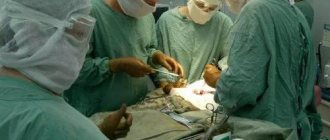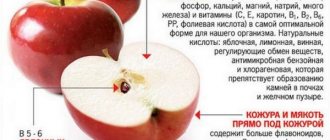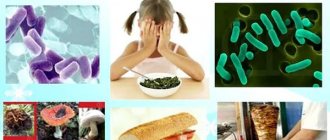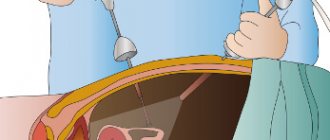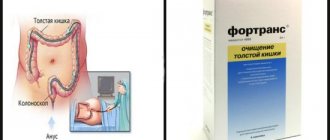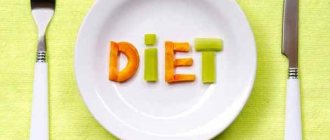What is a colonoscopy?
Colonoscopy is a hardware type of examination of the large intestine. The essence of the method: a thin tube equipped with a lighting device and optical equipment is inserted into the anus. Modern fiber colonoscopes have more elastic probes, and there are video cameras that transmit images to a monitor.
For the procedure to help in diagnosis, preliminary cleansing of the intestines is necessary. At the preparatory stage, the doctor prescribes a slag-free diet for 3-7 days. Foods that are difficult to digest, contain fiber, fats, cause gas formation, and irritate the intestines are excluded from the diet. Additionally, special laxatives and enemas are used for cleansing. Each patient is interested in the correct fulfillment of the requirements, since the procedure is unpleasant, and one does not want to repeat it due to unreliable data.
The capabilities of endoscopic technology with a high probability make it possible to identify the slightest deviations in the structure of the inner membrane, foci of inflammation, ulcers, erosions, sources of bleeding, scars, foreign bodies, and neoplasms. Tissue is taken from different points for biopsy examination, which serves as an important diagnostic method for detecting colon cancer at an early stage.
Consequences of a medical procedure for the gastrointestinal tract
The recovery period begins on the day of the study and lasts about a week. In addition to a gradual expansion of the diet, it includes restrictions on the regimen (smoking, active physical activity is undesirable), and herbal medicine techniques. If a patient suffers from chronic diseases of the digestive system, then the main task is to bring him to his usual menu.
Colonoscopy is rare, but does cause complications. Sometimes they are dangerous to humans and require urgent surgical intervention. Undesirable consequences include:
Perforation of the intestine by the tip of the probe - the frequency is no more than 1% of all cases. This complication is difficult to diagnose immediately if the patient’s consciousness is confused by sedatives or disabled by anesthesia. It is to eliminate such a risk that endoscopists try to persuade the patient to endure the unpleasant sensations and perform a colonoscopy under local anesthesia. The risk of rupture is judged by the reaction and pain when advancing the tube.
Bleeding occurs even less frequently (0.1%). It is manifested by the discharge of blood from the rectum after the examination or during the examination. Sometimes it takes several days, provoked by lifting weights and eating rough food. If a bleeding area is detected during colonoscopy, the vessel is cauterized (electrocoagulation), injected with Adrenaline solution, and the study is stopped. After a long time, it is impossible to associate intestinal bleeding with colonoscopy. Treatment is prescribed depending on the patient’s condition and the intensity of blood loss.
From practice, there are cases of infection of patients with hepatitis virus, salmonellosis, syphilis, and HIV. Such cases must be proven by epidemiological studies and testing of the sterility of equipment.
A rare complication is rupture of the spleen following perforation of the intestine and exit of the probe into the abdominal cavity.
After using anesthesia (intravenous, inhalation), breathing problems and convulsions are possible. Children are especially sensitive. Therefore, the procedure is carried out strictly according to indications and only in stationary conditions. The baby and one of the parents are observed in the hospital for several days.
For adult patients who have had an outpatient colonoscopy, it is recommended to see a doctor if:
- the temperature has risen to 38°C or more;
- increased abdominal pain;
- worried about incomprehensible nausea and vomiting;
- impurities of blood are released from the anus into the stool or a trickle;
- diarrhea does not stop, blood appears in the stool;
- feeling dizzy and weak.
What is not recommended to do after the procedure?
After therapy, do not rush to leave the clinic. The patient will need to be under the supervision of doctors for a couple of hours. This is especially necessary if general anesthesia was performed. After local anesthesia, you can go home within an hour.
After a set of procedures there are no restrictions on food and drink. But you shouldn’t eat all the food at once, otherwise constipation may occur. To prevent this from happening, you need to follow the advice of experts. In the first days after the session, you need to take easily digestible food and only in small portions.
Stool may appear within 2-3 days. But this is only after the patient has followed all the rules for eating the necessary food. Your doctor may prescribe a special diet. It is very important to take in enough fiber. This will help you go to the toilet. If this condition is not met, the stool will appear within 3 days.
After the procedure, you may feel discomfort for some time. Abdominal pain and bloating appear. These manifestations are a result of pumped air. In such a situation, it should be pumped out with a special device.
If, after a colonoscopy, painful urges appear in the abdomen, it is recommended to take activated charcoal. Take pills at the rate of one piece per 10 kilograms of weight. Under no circumstances should you take laxatives or do an enema after the session.
It is prohibited to take anticoagulants. These include: Coumadin, Warfarin. These medications can thin the blood. It is allowed to replace any of these drugs with Clexane.
Nutrition after colonoscopy
Existing requirements on how to eat properly after intestinal colonoscopy help prevent complications. Any internal procedure has negative consequences. After finishing, the body needs rest to recover. You can't eat food indiscriminately. It takes up to seven days to help the intestines.
A multiple meal regimen is recommended. It is better to eat in small portions, but 5-6 times a day. In this way, it is possible to gradually load the intestines and other digestive organs. The choice of products determines the likelihood of damage to the intestinal wall, the production of protective mucus, and the restoration of local immunity. The attitude to fight infection helps to avoid secondary infection and bleeding.
Doctors advise drinking more water (2-2.5 liters) if there are no contraindications due to your general condition. The liquid does not allow stool to dry out, injure the intestines, or cause constipation.
After good preparation for colonoscopy, waste, rotting products, and toxins are removed from the colon. But at the same time, the necessary bacterial flora is lost. We will have to replenish it with special preparations (probiotics) and create conditions for the spread of prebiotics.
Principles of nutrition
The basic principles for restoring digestion after colonoscopy can be formulated as follows:
- Nutrition should ensure maximum sparing of the digestive tract. To do this, split meals are prescribed (often, but in small portions), eliminating rapid stress on the intestines. During this period, single overeating, drinking alcoholic beverages, fried or smoked meat dishes, canned food, and pickles are very harmful.
- The frequency of meals can be increased up to 6-7 times. Portions in volume should not exceed a glass. It is important to avoid long gaps between meals. Be sure to drink 200 ml of water in half an hour.
- Food products require easy digestibility, sufficient saturation with mineral salts and proteins. They provide stimulation of local immune cells and increase the resistance of the protective barrier to infection.
- The main method of cooking is steam, boiled, baking, stewing. Fried foods with a thick crust are not allowed.
- Cold foods and drinks are prohibited; hot foods should not exceed 62°C. Temperature and mechanical sparing reduces irritation of the sensitive intestinal mucosa and protects it from exposure to unnecessary factors.
The menu after a colonoscopy should ensure a complete supply of nutrients and vitamins to the body. The choice of products should be approached carefully.
Authorized Products
Nutritionists recommend a set of foods that are easily digested, improve peristalsis, but do not increase gas formation. These include:
- vegetable soups, low-fat meat or chicken broths, fish soup without spices;
- porridge cooked in water in crumbly form, cereal casseroles;
- boiled or stewed vegetable dishes from broccoli, tomatoes, carrots, zucchini, eggplant;
- from greens: parsley, dill;
- boiled meat, fish, steamed minced meat;
- It is better to make an omelet or boil soft-boiled eggs; it is permissible to eat 1-2 per day;
- fruits and berries of non-acidic varieties are allowed raw or in casseroles;
- The most useful dried fruits are steamed figs, dried apricots, and prunes;
- fermented milk products with a fat content of 2.5%;
- in sweets, limit yourself to marmalade, marshmallows, marshmallows;
- It is advisable to use yesterday’s bread (avoid baked goods), wheat, rye;
- Herbal teas with honey, berry jelly, and rosehip decoction are suitable for drinking.
Prohibited Products
It is recommended to strictly observe the ban in the first 2-3 days after the procedure. Then all products are gradually introduced under the control of intestinal function.
- dishes from fatty fish or meat in the form of rich broths, smoked, fried products;
- salted, pickled, canned foods;
- legume porridge (peas, lentils, beans, chickpeas, beans);
- from cereals - rice, sago, spelt, pearl barley;
- different types of pasta;
- mushrooms, white cabbage;
- radishes, turnips, radishes, onions, garlic;
- fried eggs;
- strong tea, coffee, cocoa;
- hot sauces, ketchups, seasonings;
- animal and cooking fats;
- confectionery, fresh baked goods.
How to eat after a colonoscopy?
You can start eating food on the day this diagnostic or therapeutic procedure is completed. Although this examination is minimally invasive, the intestinal wall may be injured during the procedure. In this regard, for the fastest possible regeneration of the intestinal mucosa, the patient will need to limit nutrition after the procedure. To restore normal digestion, you must adhere to the following principles:
- A gentle diet after a colonoscopy. It is better to practice fractional meals, and also to exclude from the diet ingredients that put a strain on the gastrointestinal tract. Overeating, drinking alcohol, pickles and canned food are prohibited.
- Increase the frequency of daily meals to 6-7 times. The menu after a colonoscopy during the week should include a short period of time between meals, but one serving should be no more than a glass.
- Fast and easy digestibility of products. Meals should include dishes that are sufficiently rich and well-balanced.
- Cooking by steaming or in the oven. Meals after colonoscopy under anesthesia cannot include fried foods with a thick, fried crust.
- Temperature conditions. It is important to note that food can only be eaten warm. It should not be cold or hot (high and low temperatures are irritating).
Features of stool after colonoscopy
Before the procedure, all measures were taken to cleanse the intestines and retain stool. Therefore, the absence of toxins from the applied diet is expressed in temporary constipation. Usually, with proper nutrition, feces are formed in sufficient quantities by the third day. If there is not enough fiber in the diet, the delay lasts longer.
Important! During this period, you cannot stimulate the intestines with enemas and laxatives. Functional disorders are eliminated by diet.
Sometimes diarrhea is a consequence of a colonoscopy. It most often affects people who have taken a significant dosage of laxatives during the preparation period.
Another reason is the reaction of the nerve endings of the intestine to the mechanical action of the endoscopic tube, expressed in increased peristalsis. Typically recovery occurs within 2-3 days.
For prolonged diarrhea, the doctor prescribes:
- Smecta - for absorption and removal of unwanted residues.
- Loperamide - to reduce intestinal muscle tone and water retention.
- Hilak forte - in order to restore the balance of beneficial intestinal microflora involved in food processing.
The drugs should be taken according to the schedule in the required dosage.
You should not eat uncontrollably after a colonoscopy. The postponed procedure necessarily affects the functioning of the intestines. Patients need to protect the body and allow digestion to fully recover. Your doctor's advice on diet and regimen during this period will help you return to your normal diet.
A slag-free diet before a colonoscopy is a diet that can be used to quickly and efficiently cleanse the intestines before a colonoscopy, namely to remove fecal accumulations that accumulate during gastrointestinal diseases and prevent the formation of new accumulations.
Nutrition after intestinal colonoscopy with Fortrans
The drug Fortrans is a powerful laxative, the active substance of which is Macrogol. Taking Fortrans before a colonoscopy allows you to instantly cleanse the intestines before endoscopic examination and operations. After cleansing with Fortrans, patients may experience some stool disorders for another 5-7 days after the manipulation.
This is due to the following factors:
- The need for repeated cleansing (for example, with fecal stones, chronic constipation);
- Non-compliance with the regimen and dosage.
After colonoscopy using Fortrans, persistent diarrhea may occur. Upon completion of the study, patients are recommended to saturate their diet with fiber or coarse fiber, which will relieve increased gas formation, flatulence, as well as dyspepsia associated with a violation of the drug regimen.
The diet must include rice, a decoction of rice cereal, and a decoction of oak bark. These products help consolidate stool and reduce the risk of long-term diarrhea and bowel disorders.
In some cases, diarrhea can be treated with the following medications::
- Smecta . An absorbent agent that stabilizes the mucous barrier. For patients, 1 sachet 2 times a day is enough to improve stool.
- Hilak-Forte . A drug for the normalization of intestinal microflora, promotes the formation of normal feces. Hilak is taken 30 drops per day, previously dissolved in water.
- Loperamide . The drug is aimed at reducing intestinal motility and increasing the period of passage of intestinal contents. In addition, water absorption and the formation of normal feces are stimulated.
The main indicator of colonoscopy without consequences is healthy, formed stool, 3-4 days after the manipulation. Typically, the first urge to defecate occurs 2-3 days after the endoscopic procedure.
Indications for use
The diet is incomplete and, when used for a long time, causes a deficiency of nutrients in the body. The maximum period during which this nutrition can be used without harm to the body is up to 5 days.
Rules for a slag-free diet
The basic principles of a slag-free diet concern the food intake and serving size a few days before the procedure, as well as the list of permitted and prohibited foods.
In order for preparation for intestinal colonoscopy to be successful, you must follow the basic nutritional rules:
- exclude prohibited foods from the diet for a period of 5 to 3 days before endoscopic examination;
- eat 5 times a day in small portions (every 3 hours);
- drink a lot of water (2-3 liters) to improve digestion;
- on the last day, small amounts of food should be consumed in the first half of the day (at 8.00, 11.00 and 14.00).
The last day before a colonoscopy, you should eat liquid meals in the form of broth, puree soup, yogurt to quickly move stool and cleanse the intestines by the appointed time. The evening before the examination, as a rule, additional means are used to cleanse the intestines in the form of laxatives or an enema.
What you can and cannot eat (table)
The main property of products that are allowed on a slag-free diet is the minimal amount or absence of fiber in the composition. Despite the fact that fiber is a very valuable element of nutrition, consuming foods high in fiber increases the bulk of the stool and also leads to increased gas and bloating.
| Grocery list | What can you eat | What not to eat |
| Flour products | White bread and yeast-free baked goods made from white flour (muffins, cookies). Crackers, pasta | Bread and pastries made from whole grain flour, bread with added grains, seeds, nuts, raisins |
| Cereals | White rice | Oatmeal, granola and all other types of cereals. Legumes |
| Meat | All types of meat, poultry, fish and meat broths | |
| Dairy | Milk, yogurt, sour cream, cottage cheese | Yoghurts with added nuts, fruits and berries |
| Eggs | Allowed | |
| Oil | All types of oils | |
| Beverages | Coffee, tea, cocoa with sugar. Juice without pulp | Fruit and vegetable juices with pulp. Drinks with bright red or purple colors |
| Vegetables | Canned or boiled carrots, asparagus, mushrooms, potatoes (necessarily peeled). Cucumbers without skin and seeds. Vegetable puree soups from permitted vegetables and broths | Vegetables with seeds, peel, as well as corn, peas, cabbage, beans, onions, garlic, etc. Greenery |
| Fruits | Ripe fruits without seeds and skin in small quantities. Fruit juice without pulp | Fruits with seeds, shell, hard, unripe. All varieties of dried fruits |
| Nuts, seeds | All varieties of nuts and seeds | |
| Dessert | Hot, dark, milk chocolate, pudding, ice cream, sorbet, jelly without dyes and fruit pulp, honey, candies | Sweets and baked goods with the addition of coconut flakes, nuts, seeds, grains, dried fruits, raisins, dried apricots, prunes, etc. Desserts with bright red and purple dyes. Jam, popcorn |
The day before the procedure, meals should consist of a large number of drinks and three small meals (in liquid and puree form):
- water, tea, coffee, compote, jelly, apple juice (all without adding berries and fruits);
- vegetable, meat, fish broth without adding vegetables and cereals;
- a small piece of meat or fish in broth.
On the last day before the procedure, it is forbidden to consume milk and fermented milk dishes, stewed vegetables, orange, tomato and grapefruit juices.
Diet menu before colonoscopy for 3 days
When drawing up a menu for a slag-free diet, it is necessary to take into account the possible feeling of hunger, which quickly sets in after drinking vegetable, fruit juices and sugar, as well as the lack of slow carbohydrates in food, which contributes to a decrease in performance.
In order for the diet in preparation for intestinal colonoscopy to be successful, you should adhere to several rules when preparing your diet:
- include protein in food 2 times a day (meat, fish, poultry, eggs);
- eat jelly, as the dish gives you a feeling of fullness for a long time;
- eat puree soup or stewed vegetables every day;
- include fermented milk dishes in the daily diet 1-2 times a day;
- do not overeat permitted desserts and baked goods made from white flour, but consume one small portion once a day.
3rd day
- Breakfast: sandwich with cheese and boiled meat, tea.
- Lunch: berry jelly without pulp.
- Lunch: steamed meatballs (minced meat with white rice), cocoa, 3 crackers.
- Afternoon snack: fruit juice.
- Dinner: cottage cheese with yogurt and honey.
2nd day
- Breakfast: stewed fish with carrot puree.
- Lunch: fruit juice.
- Lunch: creamy mushroom soup, tea, 10 grams of chocolate.
- Afternoon snack: milk jelly.
- Dinner: boiled potatoes (1-2 pcs.), cucumber without skin and seeds.
Colon cleansing drugs
The diet before intestinal colonoscopy is not the only condition for preparing for the procedure, since it does not guarantee 100% cleansing of the lower intestines. Also, to further prepare the rectum and sigmoid colon for visual examination, it is necessary to use medications or perform an enema.
Colon cleansing medications, which are most often used before a colonoscopy, have an osmotic effect - they interfere with the absorption of water in the large intestine, while creating pressure, which causes rapid emptying of the rectum.
Laxatives have a mild effect on the gastrointestinal tract, are not absorbed during the digestion of food and efficiently cleanse the lower gastrointestinal tract:
The use of laxatives is indicated in the afternoon before colonoscopy.
For allergies to laxatives, castor oil is used. On the day before the examination (at 14.00-15.00), drink 2 tablespoons of castor oil. It is important not to eat food 2 hours before taking the oil, and after that you should refrain from any food.
An enema is an alternative to laxatives and is performed in several ways:
- in the classical way using an Esmarch mug;
- with the help of microenemas - a laxative for rectal use.
Like medications, an enema is used the evening before the procedure and, if necessary, in the morning.
The choice of means for additional intestinal cleansing is carried out depending on preferences, since each presented type of procedure has its own pros and cons in use.
Quitting the diet
Nutrition after a colonoscopy is an important element in restoring the body after a slag-free diet, drinking a day, fasting and, directly, the research procedure itself.
Laxatives and a slag-free diet lead to dehydration of the body, therefore, to restore water and electrolyte balance, frequent and abundant drinking is necessary: water, compotes, vegetable and fruit juices, still mineral water.
Meals on the first day after the procedure must be dietary and contain a minimum of fiber. In fact, it is necessary to follow a slag-free diet for one more day. Immediately after the examination, you are allowed to snack on yogurt or cheese without adding fruits and berries. Next, you should eat the following foods every 3 hours:
- mashed potatoes, stewed vegetables;
- white bread, salty crackers;
- Steamed fish;
- scrambled eggs, omelet;
- fermented milk dishes;
- jelly;
- canned fruit (peaches);
- tea, compotes, juice.
The colonoscopy procedure can lead to minor injuries and inflammation of the mucous membrane of the intestinal tract, which is why for 1-2 days foods that are difficult to digest and can aggravate inflammatory processes are strictly excluded from the diet, namely:
- alcoholic drinks;
- fatty, fried foods;
- tough meat;
- foods high in fiber.
If the day after the examination there is no pain or discomfort in the abdomen, then the next day and throughout the week, gradually add foods to the diet in the following sequence:
- stewed and boiled vegetables (cabbage, beets, etc.),
- heat-treated fruits and berries in compotes and jelly,
- baked goods made from whole grain flour and products made from durum wheat,
- raw vegetables and fruits,
- nuts, peanuts, seeds, etc.
Overeating high-fiber foods after a colonoscopy may cause abdominal pain, bloating, diarrhea, or constipation, and may interfere with the recovery of the rectal and sigmoid colon lining after endoscopic examination.
Colonoscopy is considered a low-traumatic method of examining the intestines, but pain appears after it in 9 out of 10 patients. In most cases, mild to moderate discomfort after such a procedure is considered normal, but this does not mean that the patient does not need rehabilitation.
Proper recovery after colonoscopy will avoid many problems, including increased gas formation, stool upset, dysbacteriosis, and even intestinal bleeding. Within 2-3 days, the patient will have to worry about what to eat after colonoscopy, what daily routine to follow and what medications to take to eliminate discomfort in the abdomen and rectum, dizziness and other consequences of preparation for the procedure.
The importance of diet after colonoscopy
Before conducting an examination of the intestines, as is known, doctors already prescribe a strict diet. This diet is aimed at completely cleansing the intestinal walls and removing toxins.
In addition to the fact that after this diet, eating everything at once is harmful to the body, there are other important points why it is not recommended to eat all foods.
Complications after colonoscopy are possible in rare cases. However, in order to avoid various problems, it is important to follow the doctor's advice.
The procedure involves the introduction of a foreign body into the intestines, which can disrupt the microflora or lead to minor injuries to the mucous membrane. Therefore, food after the examination should not be rough or difficult to digest, and it must also help normalize the internal environment of the intestines.
It is strictly forbidden to consume fried and spicy foods; alcoholic drinks will also be inappropriate.
The load on housing and communal services should be reduced as much as possible immediately after a colonoscopy, and then you can gradually move on to your usual diet.
Diet after colonoscopy - what you can eat and drink
Experts recommend a standard approach to intestinal restoration after diagnostic procedures using a colonoscope. It includes a gradual increase in load, since after cleansing there may be problems with the absorption of food. In addition, nutrition after the procedure performs not only the main role of providing nutrients and energy. The menu is formed taking into account the fact that the intestinal walls may be injured during the examination, especially if the colonoscopy was accompanied by taking a biopsy or removing small tumors.
The basic principles that the diet implies after this diagnostic method are as follows:
- food should be easily digestible, not cause irritation of the mucous membranes and gas formation;
- food should completely cover a person’s need for nutrients, but at the same time not provoke a feeling of excessive filling of the stomach and intestines - it is recommended to eat food often (up to 6 times a day), but in small portions;
- It is advisable to plan meals at the same time to make it easier for the intestines to adapt to the stress;
- food should promote the proliferation of beneficial microflora in the intestines and the healing of damage to the mucous membranes.
In addition to the conditions for the quality, quantity and mode of food intake, experts pay attention to the need to drink plenty of fluids - at least 2 liters of fluid per day. You can drink juices, tea, and fermented milk drinks, but the bulk should be water. It will soften the stool and help the mucous membrane of the esophagus and intestines recover faster after a colonoscopy.
As for the timing, how many days you need to follow a diet and a special diet, here experts agree that long-term restrictions after a colonoscopy are not necessary. It is enough to follow special recommendations for the first 2-3 days after diagnosis. During this time, the digestive tract will fully restore its functions.
Authorized Products
The list of foods that are recommended to eat after a colonoscopy includes all food groups:
- Meat - lean veal, poultry fillet, lamb without lard. You can prepare light meat broths from them, or steam cutlets, meatballs, soufflés and casseroles from minced meat.
- Vegetables - potatoes, zucchini, pumpkin, carrots, beets, cauliflower, bell peppers. It is advisable to boil them, bake them or add them as a side dish to soups made with low-fat broth. It is advisable to refrain from eating raw vegetables, as they cause gases to form in the intestines.
- Fruits and berries - plums, peaches and apricots, watermelon and melon, apples, cranberries and lingonberries, currants. On the first day, it is better to prepare juices and fruit drinks from them, then they can be consumed fresh.
- Fish - pike perch, bream, pollock and flounder, pike, lean herring. They are steamed or baked in parchment. It is also allowed to prepare broths, cutlets, and soufflés from fish.
- Dairy products - low-fat cottage cheese, varenets, kefir, yogurt, low-fat sour cream. They are consumed with the addition of fruit or in pure form at breakfast or dinner, and on the first day and throughout the day.
- Bread and pastries - whole grain, bran bread, preferably slightly dried. For dessert you can eat biscuits and dry biscuits.
- Boiled and steamed eggs.
The listed foods in the diet after intestinal colonoscopy provide the nutritional value of the diet and are a source of fiber necessary for the proper functioning of the digestive tract.
Important! The preferred method of preparing food is boiling or stewing. If necessary, you can additionally chop or puree cooked dishes.
Prohibited Products
The list of foods that cannot be included in the diet after a colonoscopy is not as extensive as it might seem at first. First of all, these are animal products with a high fat content: lard, pork, fatty lamb, fatty sour cream and cream. Also, the diet should not include:
- products with a sharp and spicy taste, an abundance of salt, pepper, artificial flavors and dyes - sausages, semi-finished products;
- dishes and sauces with vinegar, lots of spices;
- canned food (including vegetables, fruit and meat);
- smoked and fried meat and fish dishes;
- porridge from cereals with hard shells;
- sweets and baked goods, especially rich ones, as well as fresh bread.
What can you eat after a colonoscopy?
The post-colonoscopy menu may include:
- Water. Many patients do not know whether they can drink after a colonoscopy or what to drink. The best choice is water, which can be consumed immediately after the procedure. The diet after the procedure must include daily fluid intake of at least 1.5 liters.
- Drinks with electrolytes. Some people mistakenly believe that you can only drink water after a colonoscopy. But electrolyte drinks will help combat dehydration and restore electrolyte balance.
- Vegetable soups. If your stomach hurts after a colonoscopy, then light soups made from vegetables and lean meats can eliminate intestinal irritation and normalize the functioning of the digestive tract.
- Fruit icecream. This delicacy is exactly what you can eat after a colonoscopy under anesthesia. It contains a lot of liquid and sugar, which helps speed up digestion.
- White fish. It is recommended to add this type of low-fat fish to it.
- Applesauce. Not all patients know what to eat after a colonoscopy on the first day, so they refuse to eat at all. Applesauce will be the best choice for this period. It contains fiber for easy digestion, sugars and carbohydrates to restore energy, and pectin to prevent diarrhea.
- Fried eggs. A menu for 3 meals can start with morning fried eggs. This is a soft product with a lot of protein.
Stomach hurts after colonoscopy - what to do
Discomfort in the abdominal organs can be expressed in the form of colic, which indicates increased gas formation. Abdominal pain can be dull or cutting, localized in any part of the abdomen, and its source can be not only the digestive tract, but also the ligaments between the organs in the abdominal cavity and these organs themselves. That is why, if abdominal pain appears after a colonoscopy, you first need to find out the cause of this phenomenon and determine the source of the discomfort.
So, if pain begins in the upper abdomen and around the navel, colic or a feeling of fullness appears, most likely the reason is the gases remaining after the colonoscopy. In this case, sorbents will help eliminate discomfort: Smecta, activated carbon and others. Antispasmodics based on drotaverine will help reduce pain. These same medications are used if there is pain in the lower abdomen. For patients whose source of pain after colonoscopy is the anus, it is recommended to use suppositories, which are usually used for hemorrhoids. They are used as needed in accordance with the instructions on the package.
Important! In most cases, abdominal discomfort goes away within 2-3 days after a colonoscopy. If pain persists, you should urgently consult the doctor who performed the diagnosis.
What not to do after a colonoscopy
Cleansing procedures before examining the intestines inevitably affect peristalsis - the stomach and intestines are in rest mode. Eating a lot of food and drinking a large amount of liquid at once can cause problems with the digestive system. Therefore, not all foods can be eaten after a colonoscopy and not in large quantities. The digestive system should be loaded gradually, starting with the consumption of liquid dishes and soft foods. “I’ll eat whatever I want” is not the right attitude after a colonoscopy examination.
If you do not adhere to the diet, the body may respond with stool upset. In this case, it is unacceptable to use laxatives or give an enema without the knowledge of the doctor. If you experience abdominal pain caused by residual air, you can drink activated charcoal (tablet per kilogram of body weight). You should not take blood thinners such as aspirin. Any medications must be discussed with your doctor.
How to restore the intestines after a colonoscopy
Forced bowel cleansing before a colonoscopy procedure does not go unnoticed, especially if the patient did not follow the recommendations of a nutritionist. But even with proper planning of the diet and eating regimen, stool after colonoscopy can be problematic:
- liquid with normal or increased frequency;
- too hard;
- atypical, containing mucus and blood, etc.
Such problems are caused by the fact that after the examination, disturbances in the microflora and intestinal motility are observed.
You can restore your colon's ability to function normally through diet and moderate physical activity. Regarding the restoration of intestinal microflora after examination with a colonoscope, you will have to use probiotics and prebiotics. These are drugs that cultivate and maintain healthy intestinal microflora.
Important! The method of restoring microflora using foods rich in fiber is not used after colonoscopy, since dietary fiber provokes gas formation and can injure the already irritated mucous membrane.
A much more dangerous phenomenon is when black stool appears, indicating intestinal bleeding. It requires immediate medical intervention; hiding and ignoring such a symptom is life-threatening.
What to do if you are constipated after a colonoscopy
Prolonged constipation after colonoscopy occurs in most patients who undergo this procedure. Its occurrence is considered a normal consequence of prolonged fasting (more than 16 hours) and following a low-fiber diet before the examination. Regular eating and moderate physical activity will help relieve constipation. Drinking plenty of water (at least 2 liters of water per day) will help prevent them.
If within 2 days after the examination there is no stool, although the urge to defecate occurs, it is recommended to use laxatives that accelerate intestinal motility:
Important! The use of laxatives on the first day is prohibited, as they can cause intestinal atony. You should also refrain from enemas.
What to do if you have diarrhea after a colonoscopy
Loose stools or diarrhea after a colonoscopy are less common than constipation. In most cases, its causes are dysbiosis and poor diet. This condition is fraught with dehydration, so it is recommended to drink at least 1.5 liters of still mineral water. If diarrhea after a colonoscopy does not go away within 2 days in a row, you can take the following medications:
In addition, you can use some folk remedies. For example, the bark and fruits of bird cherry, blueberry fruits, and burnet rhizomes have a good astringent effect. A decoction is prepared from them and drunk 100 ml three times a day.
Means for normalizing the environment in the intestines
An imbalance of microflora is a fairly common occurrence after a colonoscopy. This condition is expressed by the fact that the patient has rumbling in the stomach, feels fullness (which indicates gas formation), is bothered by nausea, and a feeling of heaviness.
The following drugs help restore intestinal microflora and improve digestion:
- “Linex” is a balanced pro- and prebiotic agent that can be used even before the appearance of unpleasant symptoms as a preventive measure;
- “Lactobacterin” is a product with live bacteria that helps restore microflora;
- “Bifidumbacterin” is another natural remedy with live bacteria that helps cope with the symptoms of dysbiosis;
- “Hilak Forte” is an organic property based on biosynthetic acid that supports beneficial intestinal microflora and promotes the removal of toxins from the body.
The listed drugs must be used after consultation with a doctor, since despite their safe composition they have a number of contraindications.
Features of the chair
With proper nutrition, intestinal restoration usually occurs within a couple of days. Therefore, the patient’s normal stool is observed already on the second or third day . If your diet contains few foods containing fiber, you should expect improvements much later.
Sometimes diarrhea is observed after the procedure, in which the stool has a thinner consistency and a bad odor.
This is due to the incorrect use of laxatives that were used before the procedure.
Another cause of diarrhea may be the reaction of the patient’s nervous system to the endoscopic instrument.
In addition, constipation occurs after a colonoscopy, especially if the patient does not follow a diet. Delayed bowel movements are usually associated with spasms that are observed in the rectal area.
Complications after the procedure
Complications during intestinal colonoscopy are extremely rare. In most cases, this is due to improper preparation for the examination or a violation of the diet during the recovery period. In rare cases, medical error occurs.
What negative consequences of the procedure may concern the patient:
- burning and pain in the anus, which intensify when sitting, straining and during defecation - they are often caused by anal fissures, which form when the anus is stretched at the time of insertion of the colonoscope;
- stool disorders, in which there is blood and/or mucus in the stool, indicate an imbalance of microflora and injury to the intestinal mucous membranes;
- dyspeptic disorders, in which patients are bothered by frequent nausea, sometimes vomiting, or belching with an unpleasant aftertaste, after which the nausea subsides;
- an increase in temperature within 24 hours after a colonoscopy may indicate intestinal perforation, infection and other complications;
- severe cramping or spreading abdominal pain may indicate intestinal damage;
- pale skin, severe weakness, dizziness may indicate that bleeding has begun in the intestines.
Almost all negative consequences of colonoscopy are detected in the first day or even hours after diagnosis. However, sometimes high temperature and fever, intestinal disorders and other symptoms of complications appear several days later. Therefore, doctors recommend that patients carefully monitor the condition of the body and report any deterioration to the doctor.
After a colonoscopy examination, the patient faces a difficult period, which can be overshadowed by abdominal discomfort and bowel movements. The recommendations outlined in this article will help you cope with them. The recovery time depends on how accurately they are performed.
Nutrition after the procedure
In addition to the fact that a special diet is required before a colonoscopy, nutrition after this examination is also considered a mandatory item to prevent the negative consequences of the manipulation. Diet restrictions must be observed for a week after the procedure.
The main rule of the diet is to eat food in small portions so that the intestines are not overloaded. Food should be easily absorbed by the body. Products should contain as many vitamins, protein, and beneficial microelements as possible. All these substances prevent infectious pathologies and hemorrhages in the intestines. Overeating after the examination is strictly prohibited.
